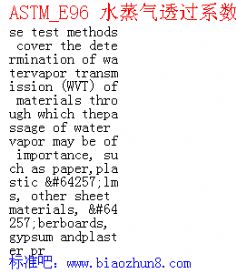ASTM_E96 水蒸气透过系数
时间:2014-8-7 13:39:51 作者:1223938497 来源:AS 阅读:2436次

1.1 These test methods cover the determination of water
vapor transmission (WVT) of materials through which the
passage of water vapor may be of importance, such as paper,
plastic films, other sheet materials, fiberboards, gypsum and
plaster products, wood products, and plastics. The test methods
are limited to specimens not over 11
⁄4 in. (32 mm) in thickness
except as provided in Section 9. Two basic methods, the
Desiccant Method and the Water Method, are provided for the
measurement of permeance, and two variations include service
conditions with one side wetted and service conditions with
low humidity on one side and high humidity on the other.
Agreement should not be expected between results obtained by
different methods. That method should be selected which more
nearly approaches the conditions of use.
1.2 The values stated in inch-pound units are to be regarded
as the standard. Metric inch-pound conversion factors for
WVT, permeance, and permeability are stated in Table 1. All
conversions of mm Hg to Pa are made at a temperature of 0°C.
1.3 This standard does not purport to address all of the
safety problems, if any, associated with its use. It is the
responsibility of the user of this standard to establish appropriate safety and health practices and determine the applicability of regulatory limitations prior to use.
2. Referenced Documents
2.1 ASTM Standards:
C 168 Terminology Relating to Thermal Insulating Materials2
D 449 Specification for Asphalt Used in Dampproofing and
Waterproofing3
D 2301 Specification for Vinyl Chloride Plastic PressureSensitive Electrical Insulating Tape4
E 691 Practice for Conducting an Interlaboratory Study to
Determine the Precision of a Test Method5
3. Terminology
3.1 Definitions of terms used in this standard will be found
in Terminology C 168, from which the following is quoted:
“water vapor permeability—the time rate of water vapor
transmission through unit area of flat material of unit thickness
induced by unit vapor pressure difference between two specific
surfaces, under specified temperature and humidity conditions.
3.1.1 Discussion—Permeability is a property of a material,
but the permeability of a body that performs like a material
may be used. Permeability is the arithmetic product of permeance and thickness.
“water vapor permeance—the time rate of water vapor
transmission through unit area of flat material or construction
induced by unit vapor pressure difference between two specific
surfaces, under specified temperature and humidity conditions.
3.1.2 Discussion—Permeance is a performance evaluation
and not a property of a material.
3.2 water vapor transmission rate—the steady water vapor
flow in unit time through unit area of a body, normal to specific
parallel surfaces, under specific conditions of temperature and
humidity at each surface.”
4. Summary of Test Methods
4.1 In the Desiccant Method the test specimen is sealed to
1
These test methods are under the jurisdiction of ASTM Committee C-16 on
Thermal Insulation and are the direct responsibility of Subcommittee C16.33 on
Thermal Insulation Finishes and Vapor Transmission.
Current edition approved April 10, 2000. Published July 2000. Originally
published as E 96 – 53 T. Last previous edition E 96 – 92436

下载说明:
1.请先分享,再下载
2.直接单击下载地址,不要使用“目标另存为”
3.压缩文件请先解压
4.PDF文件,请用PDF专用软件打开查看
5.如果资料不能下载,请联系本站